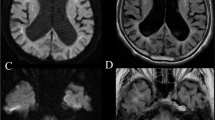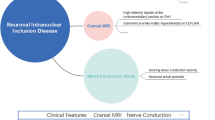Abstract
Background
Facial-onset sensory and motor neuronopathy (FOSMN) syndrome is a rare clinical syndrome in which the etiopathogenesis and disease-causing genes remain unknown. In addition, clinical and molecular pathological studies have rarely been evaluated in a large case series.
Methods
In this study, we present the clinical features and electrodiagnostic findings of the largest cohort of six patients with FOSMN in East Asia to date. Immunofluorescence assessment of TAR DNA-binding protein (TDP)-43 in muscle and skin fibroblasts, detection of GGC trinucleotide repeat expansions in NOTCH2NLC gene, and GGGGCC hexanucleotide repeat expansions in the C9orf72 gene were also performed.
Results
All patients exhibited typical symptoms and signs of FOSMN syndrome. Almost all patients showed a delayed or absent blink reflex. Neurogenic damage was found in five patients by electromyography. Two of the five patients with muscle and skin biopsies showed TDP-43-positive inclusions in both the nucleus and cytoplasm of muscular tissue and skin fibroblasts. There were no repeat expansions in the C9orf72 or NOTCH2NLC genes in any of the six patients.
Conclusions
To date, this is the largest FOSMN cohort in East Asia. TDP-43-positive cytoplasmic inclusions in muscle and skin fibroblasts may be a pathologic feature of the disease. The patient’s dynamic mutation test showed no GGC trinucleotide repeat expansions in the NOTCH2NLC and GGGGCC hexanucleotide repeat expansions in the C9orf72 gene. Further studies are needed with more patients.

Similar content being viewed by others
Data availability
The data underlying this article will be shared on reasonable request to the corresponding author.
References
Vucic S, Tian D, Chong PS, Cudkowicz ME, Hedley-Whyte ET, Cros D (2006) Facial onset sensory and motor neuronopathy (FOSMN syndrome): a novel syndrome in neurology. Brain 129(Pt 12):3384–3390
de Boer EMJ, Barritt AW, Elamin M, Anderson SJ, Broad R, Nisbet A, Goedee HS, Vazquez Costa JF, Prudlo J, Vedeler CA, Fernandez JP, Panades MP, AlbertiAguilo MA, Bella ED, Lauria G, Pinto W, de Souza PVS, Oliveira ASB, Toro C, van Iersel J, Parson M, Harschnitz O, van den Berg LH, Veldink JH, Al-Chalabi A, Leigh PN, van Es MA (2021) Facial onset sensory and motor neuronopathy: new cases, cognitive changes, and pathophysiology. Neurol Clin Pract 11(2):147–157
Liu Y, Luo J, Xiao F (2021) Facial numbness, dysarthria, muscle atrophy, and weakness in a young patient. JAMA Neurol 78(10):1273–1274
Im K, Mareninov S, Diaz MFP, Yong WH (1897) An introduction to performing immunofluorescence staining. Methods Mol Biol 2019:299–311
de Boer EMJ, Orie VK, Williams T, Baker MR, De Oliveira HM, Polvikoski T, Silsby M, Menon P, van den Bos M, Halliday GM, van den Berg LH, Van Den Bosch L, van Damme P, Kiernan MC, van Es MA, Vucic S (2020) TDP-43 proteinopathies: a new wave of neurodegenerative diseases. J Neurol Neurosurg Psychiatry 92(1):86–95
Broad R, Leigh PN (2015) Recognising facial onset sensory motor neuronopathy syndrome: insight from six new cases. Pract Neurol 15(4):293–297
Karakis I, Vucic S, Srinivasan J (2014) Facial onset sensory and motor neuronopathy (FOSMN) of childhood onset. Muscle Nerve 50(4):614–615
Zheng Q, Chu L, Tan L, Zhang H (2016) Facial onset sensory and motor neuronopathy. Neurol Sci 37(12):1905–1909
Zhang W, Huang Q, Xuan Z, Wu S, Zhao Y, Xu H (2020) Facial-onset sensory motor neuronopathy syndrome is not always facial onset. J Clin Neurol 16(4):729–730
Ohashi N, Nonami J, Kodaira M, Yoshida K, Sekijima Y (2020) Taste disorder in facial onset sensory and motor neuronopathy: a case report. BMC Neurol 20(1):71
Zhang Q, Cao B, Chen Y, Liang Y, Wei Q, Zhou D, Shang H (2019) Facial onset motor and sensory neuronopathy syndrome with a novel TARDBP mutation. Neurologist 24(1):22–25
Romano N, Catalani A, Lattante S, Belardo A, Proietti S, Bertini L, Silvestri F, Catalani E, Cervia D, Zolla L, Sabatelli M, Welshhans K, Ceci M (2020) ALS skin fibroblasts reveal oxidative stress and ERK1/2-mediated cytoplasmic localization of TDP-43. Cell Signal 70:109591
Wang X, Zhou S, Ding X, Ma M, Zhang J, Zhou Y, Wu E, Teng J (2015) Activation of ER stress and autophagy induced by TDP-43 A315T as pathogenic mechanism and the corresponding histological changes in skin as potential biomarker for ALS with the mutation. Int J Biol Sci 11(10):1140–1149
Rossor AM, Jaunmuktane Z, Rossor MN, Hoti G, Reilly MM (2019) TDP43 pathology in the brain, spinal cord, and dorsal root ganglia of a patient with FOSMN. Neurology 92(9):e951–e956
Sonoda K, Sasaki K, Tateishi T, Yamasaki R, Hayashi S, Sakae N, Ohyagi Y, Iwaki T, Kira J (2013) TAR DNA-binding protein 43 pathology in a case clinically diagnosed with facial-onset sensory and motor neuronopathy syndrome: an autopsied case report and a review of the literature. J Neurol Sci 332(1–2):148–153
Huang XR, Tang BS, Jin P, Guo JF (2022) The phenotypes and mechanisms of NOTCH2NLC-related GGC repeat expansion disorders: a comprehensive review. Mol Neurobiol 59(1):523–534
Deng J, Gu M, Miao Y, Yao S, Zhu M, Fang P, Yu X, Li P, Su Y, Huang J, Zhang J, Yu J, Li F, Bai J, Sun W, Huang Y, Yuan Y, Hong D, Wang Z (2019) Long-read sequencing identified repeat expansions in the 5′UTR of the NOTCH2NLC gene from Chinese patients with neuronal intranuclear inclusion disease. J Med Genet 56(11):758–764
Acknowledgements
We thank MyGenostics Inc. (China) for their help in completing dynamic mutation analysis.
Funding
The work was supported by Future Medical Youth Innovation Team of Chongqing Medical University (W0043), and the Young and Middle-aged Medical Excellence Team Program of Chongqing.
Author information
Authors and Affiliations
Corresponding authors
Ethics declarations
Ethical approval
The research was approved by the ethics committee of the First Affiliated Hospital of Chongqing Medical University.
Informed consent
Informed consent was obtained from all the patients.
Conflict of interest
The authors declare no competing interests.
Additional information
Publisher's note
Springer Nature remains neutral with regard to jurisdictional claims in published maps and institutional affiliations.
Rights and permissions
Springer Nature or its licensor holds exclusive rights to this article under a publishing agreement with the author(s) or other rightsholder(s); author self-archiving of the accepted manuscript version of this article is solely governed by the terms of such publishing agreement and applicable law.
About this article
Cite this article
Liu, Z., Guo, X., Guo, H. et al. Muscle and skin fibroblast TDP-43 expression, dynamic mutation analysis of NOTCH2NLC and C9orf72 in patients with FOSMN. Neurol Sci 43, 6505–6510 (2022). https://doi.org/10.1007/s10072-022-06339-7
Received:
Accepted:
Published:
Issue Date:
DOI: https://doi.org/10.1007/s10072-022-06339-7




